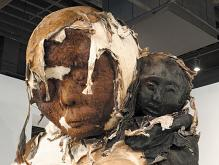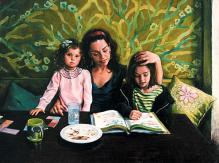Olaf Breuning turns serious issues into a laughing matter.
Tag: photography
Don’t Miss: ‘The Voting Booth Project’
Obama-mania has swept the art world this fall with myriad auctions and other fundraising events. At David Zwirner Gallery, you can do more than buy art or hobnob with politically like-minded art lovers. you can take home a piece of history from ‘The Voting Booth Project,’ an exhibition of artwork made from actual voting booths used in the 2000 election in Florida. If the memory of the faulty booths
makes you a little queasy, at least the lineup of participating artists promises to sex up the symbols of disenfranchisement by including the campy, carnivalesque assume astro vivid focus, Mickalene Thomas,
liberal user of rhinestones in her images, and Fred Tomaselli of drugs-as-collage-materials fame.
The Rema Hort Mann Foundation presents The Voting Booth Project at David Zwirner Gallery, 525 West 19th Street, Oct 14 – 25 and at Lehmann Maupin Gallery, 540 West 26th Street, November 7-8.
Hottest Show: Doug Aitken
October is the perfect month for gallery visits, when the season is back in full swing and great weather makes it irresistible to get out and see what’s new. Among the best shows is Doug Aitken’s latest solo at both locations of 303 Gallery, where the mesmerizing video ‘Migration,’ stars American migratory animals confined in rooms at a series of down-at-the-heel motels. A bison knocking down chairs, a deer sipping from the pool and beaver in the bathtub suggest that animals can survive our encroachment – but can we? Speaking of animal nature, Cecily Brown is back with more paintings exploring her signature subject matter – sex. The act is discernable in a few canvases but most are abstract, allowing viewers to make their own conclusions about where her writhing brushstrokes take us. Ernesto Neto’s social spaces are decidedly more public. For his sixth solo show at Tanya Bonakdar Gallery, a cave resembling a giant caterpillar takes up residence on the ground floor while upstairs, architectural maquettes allow visitors even more intimacy with the artist’s ideas for the space around us.
Zhang Huan, “Blessings” at PaceWildenstein Gallery
After he moved to Shanghai from New York in 2005, Chinese art star Zhang Huan hired a huge staff to man a factory-like studio; the enormous installations that fill PaceWildenstein’s two downtown galleries give ample evidence of the scale of his industry since. But the new work lacks Zhang’s signature risk-taking, making it feel safe, easy to consume—and fashionably “Chinese.”
The show’s centerpiece, a nearly 60-foot-long “painting,” is as interesting for the technique used to create it (carefully spread ash from burnt temple offerings) as for what it depicts: an ambitious Mao-era canal project with potential correlations to ambitious contemporary undertakings such as China’s massive Three Gorges Dam. Zhang’s recycling is also conceptually engaging—using highly symbolic spent materials to create something new, which, in turn, refers to the past. But in light of the artist’s past performance-art pieces, for which he coated himself in fish, oil and honey in a public latrine, or donned a “muscle” suit made of raw meat, the ash paintings lack any sense of transgression.
Likewise, a series of “Memory Doors”—intricate carvings made over historical photos adhered to ancient wooden doors—are beautifully crafted, but their subject matter (peddlers overloaded with wares, farmers loading a truck) is more illustrative of China’s shifting economy than particularly illuminating in an art sense. Ironically, the show’s most ambiguous piece—a pregnant giant, covered by animal hides and slumped as if heavily burdened—might symbolize China’s imperiled natural world, but it could also stand in for the unfortunate taming of one of China’s most provocative artists.
Delia Brown, “Precious” at D’Amelio Terras
Delia Brown paints subjects we love to hate. In the past, she’s depicted herself and her friends in a manner blatantly intended to arouse jealousy—flaunting their youth, sexiness and supposed wealth. Her latest series still unfolds amid the trappings of (borrowed) luxury, but adds cute kids as props in saccharine portraits of the artist and other women (none of whom have children, according to the gallery statement) playing happy mom. As tidy and controlled as her earlier scenes were louche, Brown’s vision of motherhood is as irritatingly unrealistic as it is incisive in exposing unattainable ideals.
Brown has claimed Mary Cassatt as an influence, but even Cassatt occasionally pictured a feeding or diaper change, labors that Brown ignores. Instead, cooperative children are seen lounging with carefully preened moms on cozy beds or couches in immaculate homes; it’s unclear whether the little darlings are “precious” for being themselves or for serving as must-have possessions.
Brown may have intended some sort of meditation on class and parenting, but the absence of affection between mothers and kids, and the sterility of their settings, are more evocative in revealing how hard it is to step into someone else’s reality. What starts out as another provocation turns into a confession of self-doubt, a 180-degree turnaround from the cockiness of her earlier work. Poignant and decidedly less frivolous, these latest panels signal that Brown is perhaps moving in a more personally risky—but meaningful—direction.

